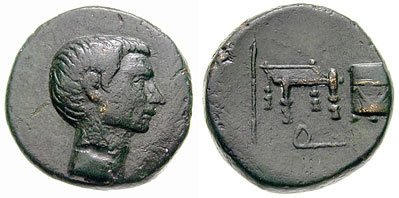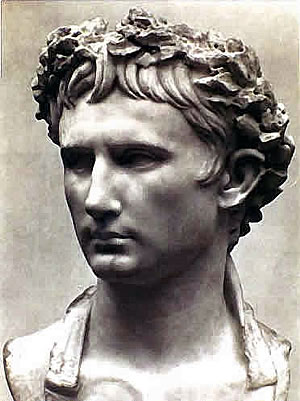|
Rationibus
The ''a rationibus'' was the secretary of finance in the Roman Empire and in charge of the imperial treasury, the ''fiscus''. His responsibilities involved monitoring the state's revenues and expenditures and maintaining the accounts of the ''fiscus'', giving the ''a rationibus'' considerable influence. The role of the ''a rationibus'' was originally created by Augustus, who needed accurate and comprehensive accounts of the state's finances in order to exercise budgetary control, and was thus given to members of his household, probably freedmen. This role was then institutionalized in the position of the ''a rationibus'', who was paid a salary by the ''aerarium'' and given an office in the Palatine bureaus, under Tiberius. Roman patrician families such as the Junii Silani may also have designated their accountants as "a rationibus", although this custom fell out of practice when the imperial office of the ''a rationibus'' became institutionalized and had vanished at the latest under ... [...More Info...] [...Related Items...] OR: [Wikipedia] [Google] [Baidu] |
Congiarium
Of Ancient Roman containers, a congiarium, or congiary (Latin, from '' congius''), was a vessel containing one congius, a measure of volume equal to six sextarii. In the early times of the Roman Republic, the congius was the usual measure of oil or wine which was, on certain occasions, distributed among the people; and thus congiarium became a name for liberal donations to the people, in general, whether consisting of oil, wine, grain, or money, or other things, while donations made to the soldiers were called '' donativa'', though they were sometimes also termed ''congiaria''. Congiarium was, moreover, occasionally used simply to designate a present or a pension given by a person of high rank, or a prince, to his friends; and Fabius Maximus called the presents which Augustus made to his friends, on account of their smallness, ''heminaria'', instead of congiaria, because hemina was only the twelfth part of a congius. Tiberius gave a congiarium of 72½ denarii (300 sesterces) to ... [...More Info...] [...Related Items...] OR: [Wikipedia] [Google] [Baidu] |
Fiscus
''Fiscus'' (Latin for "basket") was the treasury of the Roman Empire. It was initially the personal wealth of the emperors, funded by taxation on the imperial provinces, assumption of estates and other privileges. By the third century it was understood as a state fund rather than a personal one, albeit under the emperor's control. It is the origin of the English term "fiscal." Origins Augustus divided Rome's territory between senatorial provinces, whose tributes ended up in the '' aerarium'' (the already existing state's chest), and imperial provinces, whose incomes ended up into the ''fiscus'', the emperor's chest. Upon the latter chest fell the most burdensome costs, namely the ones for army and fleet, bureaucracy and grants to urban plebs (distribution of wheat or moneys). The imperial provinces, under Augustus' reform, were the provinces ''non pacatae'' (i.e., the border provinces) which Augustus had advocated under his direct administration. Those provinces, that later ... [...More Info...] [...Related Items...] OR: [Wikipedia] [Google] [Baidu] |
Roman Empire
The Roman Empire ruled the Mediterranean and much of Europe, Western Asia and North Africa. The Roman people, Romans conquered most of this during the Roman Republic, Republic, and it was ruled by emperors following Octavian's assumption of effective sole rule in 27 BC. The Western Roman Empire, western empire collapsed in 476 AD, but the Byzantine Empire, eastern empire lasted until the fall of Constantinople in 1453. By 100 BC, the city of Rome had expanded its rule from the Italian peninsula to most of the Mediterranean Sea, Mediterranean and beyond. However, it was severely destabilised by List of Roman civil wars and revolts, civil wars and political conflicts, which culminated in the Wars of Augustus, victory of Octavian over Mark Antony and Cleopatra at the Battle of Actium in 31 BC, and the subsequent conquest of the Ptolemaic Kingdom in Egypt. In 27 BC, the Roman Senate granted Octavian overarching military power () and the new title of ''Augustus (title), Augustus'' ... [...More Info...] [...Related Items...] OR: [Wikipedia] [Google] [Baidu] |
Economy Of Ancient Rome
The study of the economies of the ancient city-state of Rome and its empire during the Republican and Imperial periods remains highly speculative. There are no surviving records of business and government accounts, such as detailed reports of tax revenues, and few literary sources regarding economic activity. Instead, the study of this ancient economy is today mainly based on the surviving archeological and literary evidence that allow researchers to form conjectures based on comparisons with other more recent pre-industrial economies. During the early centuries of the Roman Republic, it is conjectured that the economy was largely agrarian and centered on the trading of commodities such as grain and wine.Garnsey, Peter, et al. The Roman Empire: Economy, Society and Culture. 2nd ed., University of California Press, 2015, www.jstor.org/stable/10.1525/j.ctt9qh25h. Financial markets were established through such trade, and financial institutions, which extended credit for personal ... [...More Info...] [...Related Items...] OR: [Wikipedia] [Google] [Baidu] |
Government Of The Roman Empire
A government is the system or group of people governing an organized community, generally a state. In the case of its broad associative definition, government normally consists of legislature, executive, and judiciary. Government is a means by which organizational policies are enforced, as well as a mechanism for determining policy. In many countries, the government has a kind of constitution, a statement of its governing principles and philosophy. While all types of organizations have governance, the term ''government'' is often used more specifically to refer to the approximately 200 independent national governments and subsidiary organizations. The main types of modern political systems recognized are democracies, totalitarian regimes, and, sitting between these two, authoritarian regimes with a variety of hybrid regimes. Modern classification systems also include monarchies as a standalone entity or as a hybrid system of the main three. Historically prevalent forms ... [...More Info...] [...Related Items...] OR: [Wikipedia] [Google] [Baidu] |
Rationalis
A ''rationalis'' was a high-ranking fiscal officer in the Roman Empire. Until replaced by the ''comes sacrarum largitionum'' by Emperor Constantine in the early 4th century, the ''rationalis summarum'' – comparable to a modern-day finance minister – was one of two state officials who had authority over the imperial treasury, the other one being the ''rationalis rei privatae'' (manager of imperial estates and city properties). Examples for tasks that were performed by a ''rationalis'' are "the collection of all normal taxes and duties, the control of currency and the administration of mines and mints". Each province also had various classes of ''rationales'', and Emperor Diocletian's administrative reforms had mirrored the dual structure on the diocesis–level, instituting the local positions ''rationalis summarum'' and ''magister rei privatae'' above the '' procuratores''. The former continued to exist after the reforms, one example are the ''comes et rationalis summarum ... [...More Info...] [...Related Items...] OR: [Wikipedia] [Google] [Baidu] |
Comes
''Comes'' (plural ''comites''), translated as count, was a Roman title, generally linked to a comitatus or comital office. The word ''comes'' originally meant "companion" or "follower", deriving from "''com-''" ("with") and "''ire''" ("go"). The special lasting meaning derives from the position of a follower within a ''comitatus'', which was a retinue, or group of followers, such as those of magnates. In some instances these were sufficiently large and/or formal to justify specific denomination, such as a "''cohors amicorum''". The word ''comes'' is the origin of the much later terms for counts within the medieval nobility, and counties as their territorial jurisdictions. Ancient Roman religion ''Comes'' was a common epithet or title that was added to the name of a hero or god in order to denote relation with another god. The coinage of Constantine I (emperor), Roman Emperor Constantine I declared him "''comes''" to Sol Invictus ("Unconquered Sun") ''qua'' god. Imperial Ro ... [...More Info...] [...Related Items...] OR: [Wikipedia] [Google] [Baidu] |
A Cognitionibus
A, or a, is the first letter and the first vowel letter of the Latin alphabet, used in the modern English alphabet, and others worldwide. Its name in English is '' a'' (pronounced ), plural ''aes''. It is similar in shape to the Ancient Greek letter alpha, from which it derives. The uppercase version consists of the two slanting sides of a triangle, crossed in the middle by a horizontal bar. The lowercase version is often written in one of two forms: the double-storey and single-storey . The latter is commonly used in handwriting and fonts based on it, especially fonts intended to be read by children, and is also found in italic type. In English, '' a'' is the indefinite article, with the alternative form ''an''. Name In English, the name of the letter is the ''long A'' sound, pronounced . Its name in most other languages matches the letter's pronunciation in open syllables. History The earliest known ancestor of A is ''aleph''—the first letter of the Phoenician ... [...More Info...] [...Related Items...] OR: [Wikipedia] [Google] [Baidu] |
Comes Sacrarum Largitionum
The ''comes sacrarum largitionum'' ("Count of the Sacred Largesses"; in , ''kómes tōn theíon thesaurōn'') was one of the senior fiscal officials of the late Roman Empire and the early Byzantine Empire. Although it is first attested in 342/345, its creation must date to ca. 318, under Emperor Constantine the Great (r. 306–337). The ''comes'' was the successor of the Principate-era '' rationalis'', and supervised those financial sectors that were left outside the purview of the praetorian prefect The praetorian prefect (; ) was a high office in the Roman Empire. Originating as the commander of the Praetorian Guard, the office gradually acquired extensive legal and administrative functions, with its holders becoming the Emperor's chief ai ...s: the taxation of senators, the '' chrysargyron'' tax, customs duties, mines, mints and state-run mills and textile factories. Initially, the ''comes'' also controlled the emperor's private domains, but these passed under the control ... [...More Info...] [...Related Items...] OR: [Wikipedia] [Google] [Baidu] |
Diocletian
Diocletian ( ; ; ; 242/245 – 311/312), nicknamed Jovius, was Roman emperor from 284 until his abdication in 305. He was born Diocles to a family of low status in the Roman province of Dalmatia (Roman province), Dalmatia. As with other Illyrian emperors, Illyrian soldiers of the period, Diocles rose through the ranks of the military early in his career, serving under Aurelian and Probus (emperor), Probus, and eventually becoming a Roman cavalry, cavalry commander for the army of Emperor Carus. After the deaths of Carus and his son Numerian on a campaign in Sasanian Empire, Persia, Diocles was proclaimed emperor by the troops, taking the name "Diocletianus". The title was also claimed by Carus's surviving son, Carinus, but he was defeated by Diocletian in the Battle of the Margus. Diocletian's reign stabilized the empire and ended the Crisis of the Third Century. He initiated the process of the Roman Empire split and appointed fellow officer Maximian as ''Augustus (title), Augu ... [...More Info...] [...Related Items...] OR: [Wikipedia] [Google] [Baidu] |
Equites
The (; , though sometimes referred to as " knights" in English) constituted the second of the property/social-based classes of ancient Rome, ranking below the senatorial class. A member of the equestrian order was known as an (). Description During the Roman Kingdom and the first century of the Roman Republic, legionary cavalry was recruited exclusively from the ranks of the patricians, who were expected to provide six (hundreds) of cavalry (300 horses for each consular legion). Around 400BC, 12 more of cavalry were established and these included non-patricians (plebeians). Around 300 BC the Samnite Wars obliged Rome to double the normal annual military levy from two to four legions, doubling the cavalry levy from 600 to 1,200 horses. Legionary cavalry started to recruit wealthier citizens from outside the 18 . These new recruits came from the first class of commoners in the Centuriate Assembly organisation, and were not granted the same privileges. By the time of t ... [...More Info...] [...Related Items...] OR: [Wikipedia] [Google] [Baidu] |







